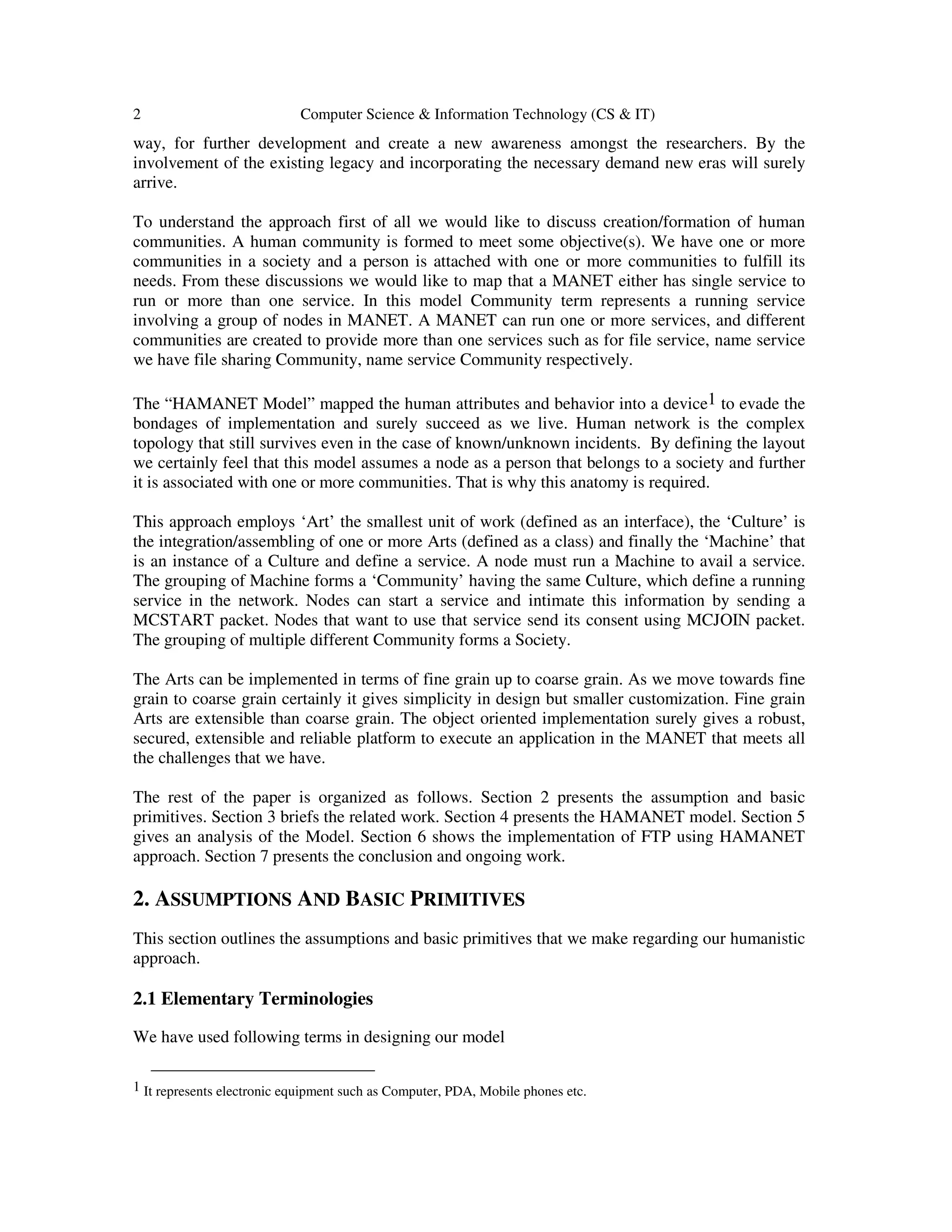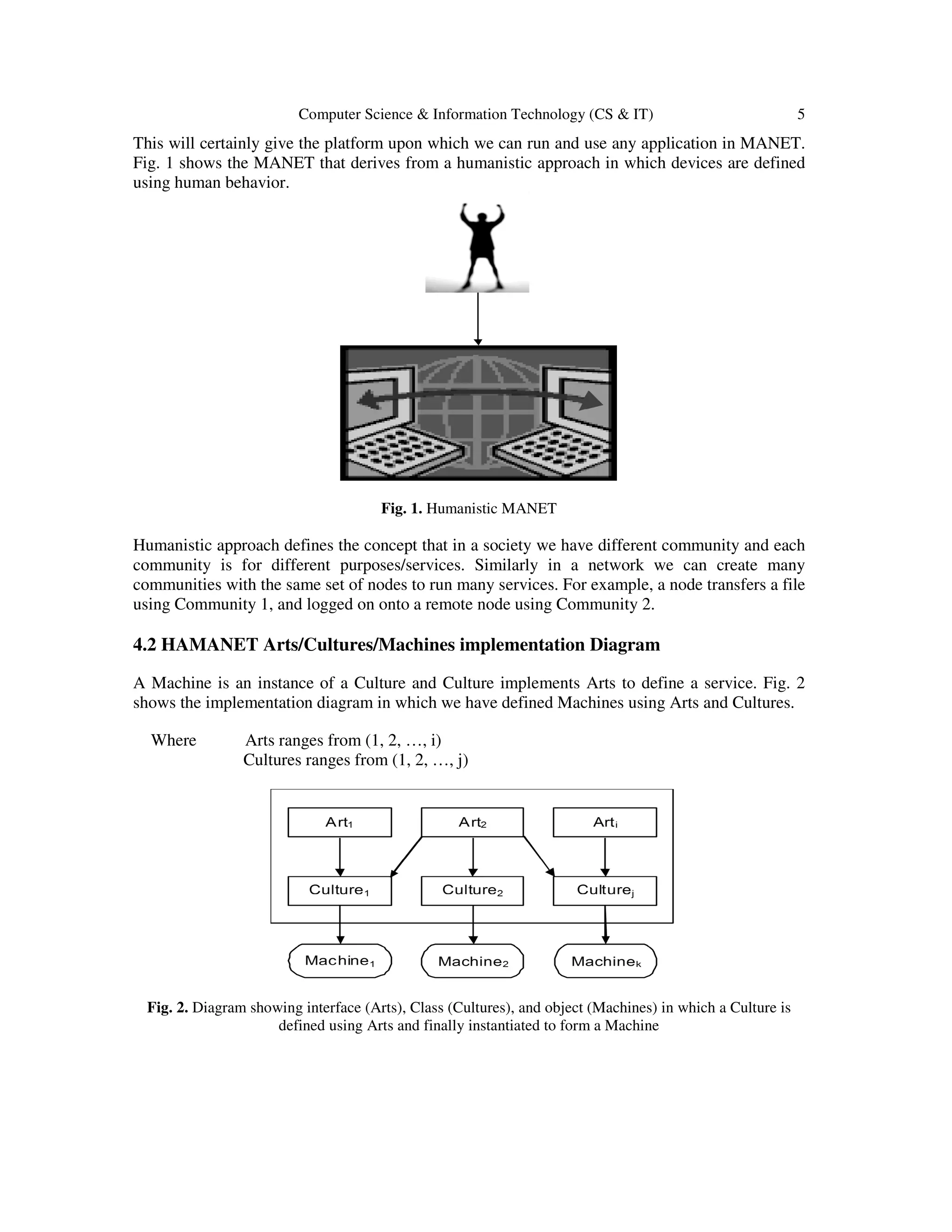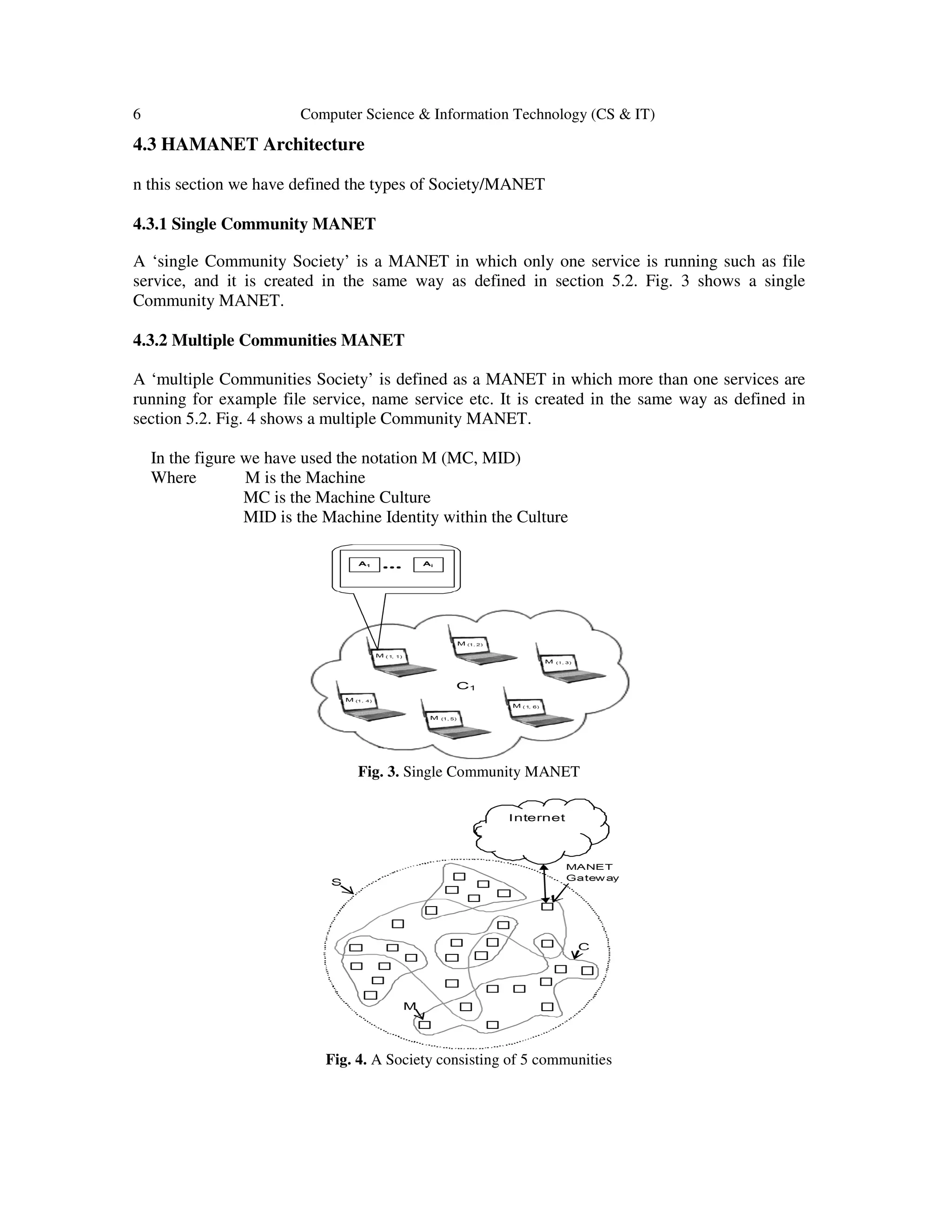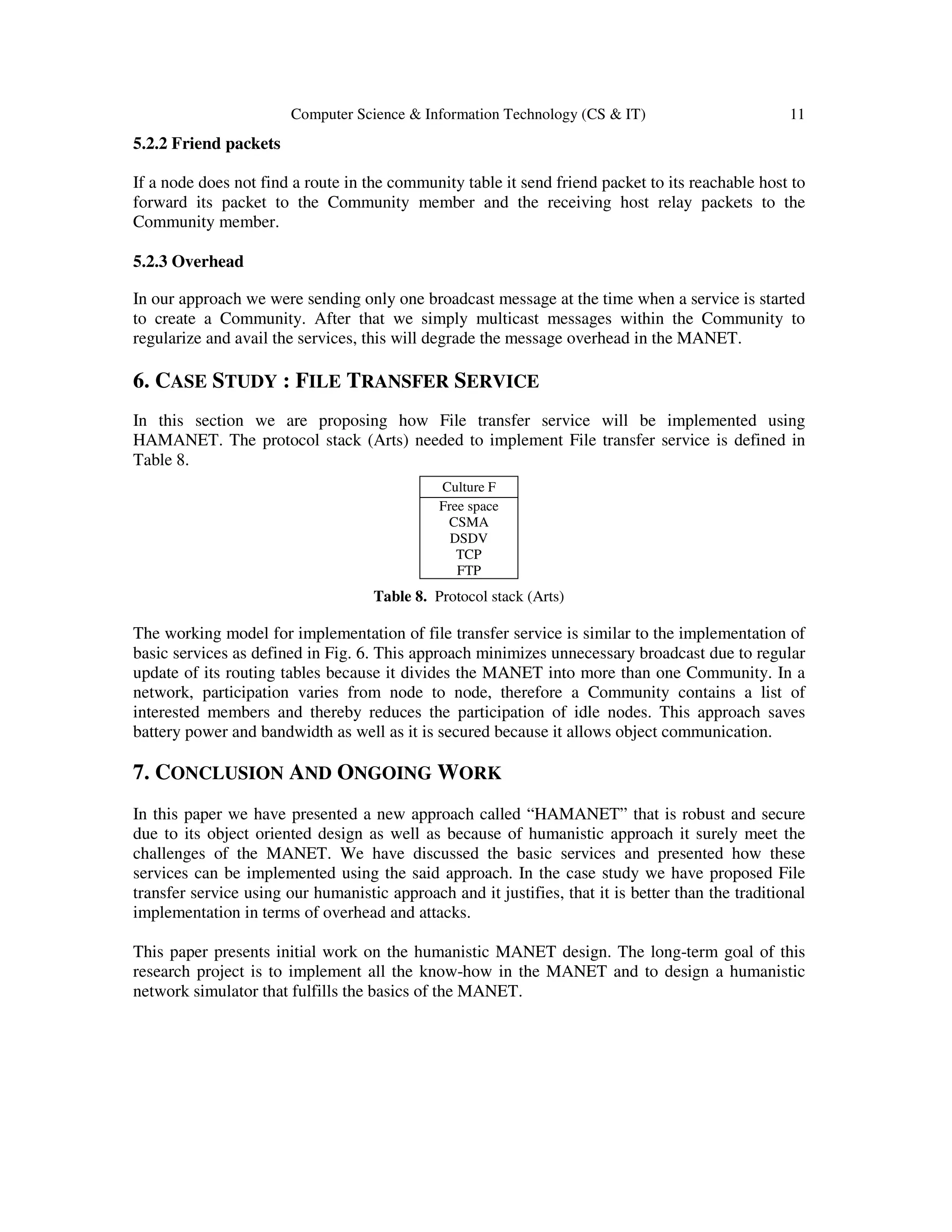The document introduces 'hamanet', a humanistic approach designed for mobile ad hoc networks (MANETs) that integrates human characteristics and behaviors into network functionality, addressing challenges like name resolution and authentication. It defines a service architecture based on 'art', 'culture', and 'machine', enabling robust, scalable, and secure network services through community formations within the network. The paper presents a comparison with existing MANET models and discusses the implementation of file transfer services using the hamanet framework.



![4 Computer Science & Information Technology (CS & IT)
3. RELATED WORK
The work which has been done so far has been very curative but it is high time to amend the ways
for an energetic means to create a new platform for more research. The bondages of this study
should finally pave a new way, for further development and create a new awareness amongst the
researchers. By the involvement of the existing legacy and incorporating the necessary demand
new eras will surely arrive.
To our knowledge, there is no such design that we have proposed and no previously published
work that meets all the challenges that we have in Mobile ad hoc networks. Lots of work has been
proposed to handle modification of routing information’s [3-7], to enforce cooperation [8] but
they have serious limitations in terms of routing overhead and attacks. Work to be done in the
area of Address allocation [17], name resolution [18, 19] shows that the implementation of these
services with the current design of MANET creates complexity and heavy network overhead.
4. HAMANET MODEL
MANETs are certainly the next generation face that announces the game, winning which we
obtain lave. The known/unknown obstacles resist the implementation, and by solving are
circumventing to utilize the resources. The aggregated/generalized form of MANET can further
specialize to esteem the demand that is why we are going to restructure the same and prevail.
Human nature would really act into the device to entrust and make it robust and secure like the
same.
4.1 Overview
Our object-oriented design defines a service in terms of Arts, Culture, and Machine. This
approach employs ‘Art’ the smallest unit of work (defined as an interface), the ‘Culture’ is the
integration/assembling of one or more Arts (defined as a class) and finally the Machine that is an
instance of a Culture and define a service. A node must run a Machine to avail a service. The
Machine defines a running service in a node, and the grouping of Machine having the same
Culture forms a ‘Community’ defined in section 4.4.
We can provide the basic services in a MANET by instantiating a Machine after fulfilling the
basic requirements for some services (for ex. Internet gateway point for name service). A SI node
broadcast MCSTART packet in the Society/MANET to intimate that a service is being started. To
join the service a node after receiving the MCSTART must send a MCJOIN packet to become a
member of the Community or it can broadcast a MCJOIN packet to register itself into an existing
Community. The lists of interested nodes that have replied by sending MCJOIN message are
listed by the SI to form a Community.
In this model a community table is used in each Community that stores CID, MID and path.
Packets are routed using the path provided in the community table. During transmission if a node
doesn’t find a route in the community table then it broadcasts a RREQ that is forwarded from
node to node either node is a member or if in is not a member it handle it as friend RREQ. When
the RREQ packet reaches to Community members, the members reply the source by sending the
community table. This model defines levels of abstraction to handle malicious or selfish attacks
as defined in section 4.5.](https://image.slidesharecdn.com/humanisticapproachinmobileadhocnetworkhamanet-131007002452-phpapp02/75/Humanistic-approach-in-mobile-adhoc-network-hamanet-4-2048.jpg)


![Computer Science & Information Technology (CS & IT) 7
4.4 Description of the Components
The HAMANET components are as follows
4.4.1 Arts Component
It defines the smallest work module(s) that is used to define a service and implemented in
Culture. Art(s) can be defined in terms of fine grain up to coarse grain. As we move towards fine
grain to coarse grain certainly it gives simplicity in design but little customization. The fine grain
Art(s) can be defined at the function level (such as RREQ, RREP, RERR, HELLO etc.), similarly
coarse grain Art(s) can be defined at the protocol level (such as Bellman-Ford, DSDV, FSR,
OSPF, WRP, LAR, DSR, AODV) [9-16]. The Arts are defined in terms of interfaces that contain
final variables and abstract methods defined in Table 2.
Table 2. Art Interface
Interface Art1
final variables;
abstract methods ();
4.4.2 Culture Component
We have used Culture to assemble Arts and defined in terms of a class as given in Table 3.
Cultures implements one or more Arts and instantiated to form a Machine.
Table 3. Culture Class
4.4.3 Machine Component and packets
A Machine is an instance of a Culture that defines a running service. To regularize its service a
machine uses various functions that are defined in Culture methods (), they are as follows.
MCSTART: Packet broadcasted to the Society/MANET to intimate that a service has been
started.
MCJOIN: Packet sends by interested Society/MANET member in response of MCSTART to join
the Community.
4.4.4 Community Component
Community means the grouping of two or more Machines having the same Culture and
communicable either directly or indirectly. Each Community maintains a community table listing
all the members of the Community. The community table for node N1 is defined in Table 4.
Class Culture1 implements Art1, Art2, …, Arti
Culture variables;
abstract methods (); // implementation of Arts interfaces
Culture methods ();](https://image.slidesharecdn.com/humanisticapproachinmobileadhocnetworkhamanet-131007002452-phpapp02/75/Humanistic-approach-in-mobile-adhoc-network-hamanet-7-2048.jpg)
![8 Computer Science & Information Technology (CS & IT)
Table 4. Community Table
MID CID PATH
N2 C1 N1-N2
N3 C1 N1-N3
N4 C1 N1-N2-N4
4.4.5 Society Component
All Communities finally constitute a Society that is defined for diverse goals. The Society Table
is defined in Table 5.
Table 5. Society Table
4.5 Levels Of Abstraction
The communication between Machine object hides the internal details. The description of data at
the object level is in a format independent of its Arts and Culture representation. Our work
defines various levels of abstraction to minimize the complexity and protect the system from
selfish and malicious threats as is given in Fig. 5.
Our object oriented design confirms that only defined operations can be executed with nodes
because data’s are wrapped by operations, which protects our network from malicious and selfish
attacks.
Fig. 5. Levels of Abstraction
5. ANALYSIS OF THE MODEL
In this section we are describing the comparison and implementation of basic services.
5.1 Comparison between HAMANET Structure & GloMoSim Layers
The GloMoSim Layers [2] and the HAMANET Structure is given in Table 6 and Table 7
respectively. Through these tables we are comparing our proposed architecture with GloMoSim
architecture.
CID MC
C1 File service
C2 Name Service](https://image.slidesharecdn.com/humanisticapproachinmobileadhocnetworkhamanet-131007002452-phpapp02/75/Humanistic-approach-in-mobile-adhoc-network-hamanet-8-2048.jpg)
![Computer Science & Information Technology (CS & IT) 9
Table 6. Layered Structure of GloMoSim
Table 7. HAMANET Structure
5.2 Implementing Basic Services
The Aleksi Penttinen [1] defined various challenges and services such as Address allocation,
name resolution, authentication. Work to be done in the area of Address allocation, name
resolution [17, 19] shows that the implementation of these services with the current design of
MANET creates complexity and heavy network overhead. These services can be implemented
using HAMANET without such problems.
To explain the implementation of these services first we relate our concept with creation of
community in human. For example to create a community or club for some specific activity, two
or more persons joined and make a community and then they add interested members and avail
the service.
Layer Protocol
Physical
(Radio Propagation)
Free space, Two-Ray
Data Link (MAC) CSMA, MACA, TSMA, 802.11
Network (Routing)
Bellman-Ford, FSR, OSPF, DSR, WRP,
LAR, AODV
Transport TCP, UDP
Application Telnet, FTP
Arts
Physical
(Radio
Propagation)
Data Link
(MAC)
Network (Routing) Transport Application
Free space
Two-Ray
CSMA
MACA
TSMA
802.11
Bellman-Ford
OSPF
FSR
DSR
WRP
LAR
AODV
TCP
UDP
Telnet
FTP
Cultures
Culture 1 Culture 2 Culture 3
Free space
CSMA
Bellman-Ford
TCP
FTP
Two-Ray
802.11
DSR
TCP
CBR
Two-Ray
CSMA
AODV
TCP
Telnet](https://image.slidesharecdn.com/humanisticapproachinmobileadhocnetworkhamanet-131007002452-phpapp02/75/Humanistic-approach-in-mobile-adhoc-network-hamanet-9-2048.jpg)


![12 Computer Science & Information Technology (CS & IT)
REFERENCES
[1] Aleksi Penttinen, “Research on Ad Hoc Networking: Current Activity and Future Directions”,
Networking Laboratory, Helsinki University of Technology, Finland. See also
http://citeseer.nj.necm.com/533517.html
[2] http://pcl.cs.ucla.edu/projects/glomosim/
[3] K. Sanzgiri, B. Dahill, B. Levine, C. Shields, and E. Belding-Royer, “A secure routing protocol for ad
hoc networks,” in the 10th IEEE International Conference on Network Protocols (ICNP), November
2002.
[4] M. G. Zapata and N. Asokan, SAODV “Securing ad-hoc routing protocols”, in the 2002 ACM
Workshop on Wireless Security (WiSe 2002), September 2002, pp.1-10.
[5] Y. Hu, A. Perrig, and D. Johnson. Ariadne: “A Secure On-Demand Routing Protocol for Ad Hoc
Networks”, In Proceedings of the Eighth Annual International Conference on Mobile Computing and
Networking, September 2002, pages 12-23.
[6] Johnson, and A. Perrig. SEAD: “Secure Efficient Distance Vector Routing in Mobile Wireless Ad
Hoc Networks’, in Fourth IEEE Workshop on Mobile Computing Systems and Applications, June
2002, pages 3-13.
[7] P. Papadimitratos, Z. Haas and P. Samar. “The Secure Routing Protocol (SRP) for Ad Hoc
Networks”, internet-Draft, draft-papadimitratos-securerouting- protocol-00.txt, December 2002.
[8] S. Marti, T. J. Giuli, K. Lai, and M. Baker, “Mitigating routing misbehavior in mobile Ad hoc
networks,” in Proceedings of the 6th annual international conference on Mobile computing and
networking (ACM MobiCom 2000), pp. 255–265, New York, NY, USA, 2000.
[9] RE Bellman, “On a routing problem”, Quarterly of Applied Mathematics, 16 (1958), pp. 87–90.
[10] Y. Hu, D. C.E. Perkins & P. Bhagwat, “Highly Dynamic Destination-Sequenced Distance Vector
Routing (DSDV) for Mobile Computers”, Proceedings of ACM SIGCOMM'94, London, UK, Sep.
1994, pp. 234-244.
[11] Guangyu Pei, M. Gerla, and TsuWei Chen, “Fisheye state routing: a routing scheme for ad hoc
wireless networks”, Communications 2000 ICC 2000, 2000 IEEE International Conference on, 1:70–
74 vol.1, 2000.
[12] Moy, J., "The OSPF Specification", RFC 1131, October 1989.
[13] Shree Murthy and J. J. Garcia-Luna-Aceves, “An Efficient Routing Protocol for Wireless Networks”,
Mobile Networks and Applications, 1(2):183–197, 1996.
[14] Y. B. Ko, and N. H. Vaidya, “Location-Aided Routing (LAR) in Mobile Ad hoc Networks”,
Proceedings of the 4th annual ACM/IEEE international conference on Mobile computing and
networking, 1998.
[15] Johnson, D. Maltz, and Y.C. Hu, “The Dynamic Source Routing Protocol for Mobile Ad Hoc
Networks (DSR),” IEEE Internet Draft, Apr. 2003.
[16] C. Perkins, E. B. Royer, S. Das, “Ad hoc On-Demand Distance Vector (AODV) Routing”, IETF
Internet Draft, 2003.
[17] Xiaonan Wang, Yi Mu, “A secure IPv6 address configuration scheme for a MANET”, Security and
Communication Networks, 2012, doi: 10.1002/sec.611
[18] M. Nazeeruddin, G.P. Parr, B.W. Scotney, “An efficient and robust name resolution protocol for
dynamic MANETs”, Ad Hoc Networks, Volume 8, Issue 8, November 2010, Pages 842-856
[19] Mohammad Masdari, Mehdi Maleknasab, Moazam Bidaki, “A survey and taxonomy of name systems
in mobile ad hoc networks”, Journal of Network and Computer Applications, Volume 35, Issue 5,
September 2012, Pages 1493–1507](https://image.slidesharecdn.com/humanisticapproachinmobileadhocnetworkhamanet-131007002452-phpapp02/75/Humanistic-approach-in-mobile-adhoc-network-hamanet-12-2048.jpg)